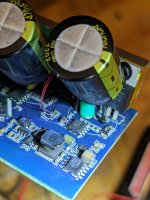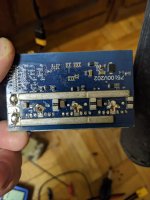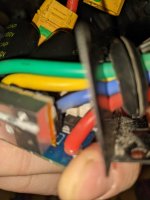rg12 said:
So I'm left with two questions here:
1. Will changing caps to a higher voltager 150V/200V? be enough to solve the issue?
Ultimately, without knowing all the ratings of all the other components on the board, the only way to find this out would be to try it and see what happens. If it has survived >100V already on the bench, then this is a promising start, although you can't rule out any one of a number of components failing once you get it out on the road. For your own safety and others', you should be prepared for it to fail at any time.
I think that to be assured that this ESC will work reliably and safely at >100V then upgrading the capacitors could possibly be first one of several changes that you would have to do.
Don't get me wrong, installing higher voltage capacitors would certainly help, but you also need to consider that other attributes of those capacitors have been carefully chosen to work in harmony with other components on the board. Capacitors have something called 'ESR' and if you change the ESR of your capacitors, there is a chance of causing other problems further down the line if you don't choose your replacement capacitors carefully.
Many VESC based designs have two sets of caps. 1. the large round electrolytic capacitors you can see, plus: 2. Several small ceramic surface mount capacitors on the board which often look like brown/beige coloured unmarked SMT components. The designer of the board does a calculation to ensure these two sets of capacitors, both their capacitance and their ESR ratings are values that work in harmony with each other. The large electrolytics smooth out slow voltage spikes, and the small ceramics smooth out the fast voltage spikes. If you change one value without considering the other value, you can upset the system and cause more problems for the mosfets further down the line.
rg12 said:
* I was always worried about the buck converter on the pcb that takes the pack voltage down to 5V to run the circuit as overvolting them may blow them up
Yes this could also be a problem too. You could look at the markings of the buck converter chip and try and look up it's max voltage. However, all the supporting components, resistors, capacitors, inductor etc. around the buck converter will also have been chosen to operate inside a certain voltage window and you don't know what the designer set that window of operation to be.
rg12 said:
I don't understand how a 24S pack on a 24S rated controller be any different.
If you are running a controller which is rated by the manufacturer for safe operation at 24S, then all the components - capacitors, mosfets, buck converter, everything else, will have been chosen for safe operation at far higher than 100.8V pack voltage. For example, this is one of the reasons why the VESC 100/250 controller has 200V rated caps which is to give enough headroom in case of voltage spikes.
You never know, it might be just fine as it is, but the only way you will find out is trying it and seeing if it lets out the magic smoke.
Your testing has actually encouraged me to buy one of these controllers. If it survives on 24S even for a short time, then it hopefully should be fairly robust when used within the normal window of it's 16S-20S rating!!
Please do report back and let us know what happens!








